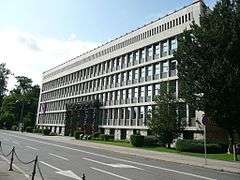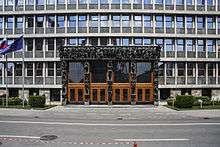National Assembly Building of Slovenia
The National Assembly Building (Slovene: Zgradba Državnega zbora, also colloquially the Parliament (Parlament) in Ljubljana, the capital of Slovenia, is a modernist palace housing the legislature of Slovenia. Built between 1954 and 1959 by the architect Vinko Glanz, it is a three-storey building with an area of 2,200 m2 (24,000 sq ft). It is located on the Republic Square in the center of Ljubljana. Annual visitor numbers are around 13,000.[1]
| National Assembly Building | |
|---|---|
Zgradba Državnega zbora (in Slovene) | |
 National Assembly Building, Ljubljana | |
 Location within Slovenia | |
| Former names | Palace of the People's Assembly (Palača Ljudske skupščine) |
| Alternative names | Parliament (Parlament) |
| General information | |
| Location | Republic Square |
| Town or city | Ljubljana |
| Country | Slovenia |
| Construction started | 1954 |
| Completed | 1959 |
| Owner | Slovenian Parliament |
| Technical details | |
| Floor area | 2,200 m2 (24,000 sq ft) |
| Design and construction | |
| Architect | Vinko Glanz |
| Structural engineer | Alojzij Čigon |
| Main contractor | Tehnika |
| Website | |
| www | |
Despite its name, the building houses both the National Assembly (lower house) and the National Council (upper house) of the legislature. The building is an officially protected monument, listed in the records as the People's Assembly Building of the Republic of Slovenia (Skupščina Republike Slovenije). It was opened on 19 February 1959 as the Palace of the People's Assembly (Palača Ljudske skupščine), because it was built in the time when the Socialist Republic of Slovenia had a People's Assembly.
Construction

The Cathedral of Freedom is an unrealised project of the Slovenian Parliament building, designed by the architect Jože Plečnik in 1949. It featured a large cone-shaped roof of 394 ft (120 m) high but failed to result in any action.[2] A new legislature building was thereafter planned by the architect Vinko Glanz, a much more conservative and modest design than either of the Plečnik concepts, being an austere modernist palace with no monumental elements or decorations save a large sculptural group of bronze figures framing its main portico.[3]
Work began in 1954 on construction of the building to Glanz's plans, using Tehnika, a Ljubljana construction firm.[4] Part of the ethos was that local building materials should be used, such as wood, stone and marble.[3] 27 master craftsmen were also used for the metalwork and joinery. It was completed in 1959.[4]
Opening
The building, opened as the Palace of the People's Assembly, hosted the first session of the People's Assembly of the Republic of Slovenia on 19 February 1959.[4]
For its first 32 years, the building held meetings of the Assembly of the Socialist Republic of Slovenia. Following the independence of Slovenia in 1991, it gave way to use by the Slovenian Parliament: both the National Assembly and the National Council.[3]
Design
Exterior architecture

The four-storey building is externally austere. A freestanding cube,[5] the main façade faces Republic Square and is inlaid with Karst marble, with green Oplotnica granite below each window. The only decorative element is the two storey main portal – four oak doors surrounded by statues by Zdenko Kalin and Karel Putrih which represent working people.[6][3][7]
Interior
Inside, the building is furnished with paintings and frescoes by a selection of Slovenian artists. The largest, a 67.4 by 1.4 metres (221.1 by 4.6 ft)[4] wall painting by the 20th century mural artist Slavko Pengov, extends across the length of the entrance hall and illustrates the history of Slovenians. Created in 1958 and 1959, the mural portrays events including the Revolutions of 1848, the First World War and the 1918 creation of the Kingdom of Serbs, Croats and Slovenes, the Second World War and national liberation, and the creation of socialist Yugoslavia and homeland reconstruction.[8] The walls of the first-floor corridor are furnished with portraits of former Presidents of the National Assembly.[3] Following the 1991 independence of Slovenia, the building's interior has been refurbished several times to suit the desideratum of the new Slovenian Parliament.[6]
The center of the building is occupied by the 422 m2 (4,540 sq ft), 150 seat Great Hall, where the National Assembly convenes. Formerly rectangular, it was renovated into an amphitheater in 2000. Each seat has a microphone, an automatic voting system, plug socket and access to the National Assembly's computer network.[9] The chair facing the doors to the hall is for the President of the National Assembly. Behind it, a bronze relief of the coat of arms of Slovenia is positioned on the marble wall. The sculptor Marko Pogačnik created the work in 1991 to celebrate independence. There is also a 106-seat gallery for the public and guests to view the Great Hall.[9]
The National Council holds its meetings in the Small Hall, on the ground floor. The room is also used for public presentations and conferences.[10]
Incidents
On 18 May 2010, the front façade of the building, made of rare green tonalite, was severely damaged by students who threw granite rocks removed from a nearby pavement at the building's main entrance. The incident happened during a large student protest against the proposed law on the introduction of mini jobs that would curb student work and changes to scholarship policy.[11] Repairs to the building were estimated at 27,000 euros.[12]
References
- "Praznunemo 20 Let Slovenskega Parlamenta [Celebrates 20 Years of Slovenian Parliament]" (in Slovenian). Archived from the original on 20 April 2016. Retrieved 15 February 2016.
- Wise, Michael Z. (16 October 1993). "The Designs of Slovenia's Joze Plecnik: An Idiosynchratic Architect". The New York Times. Retrieved 16 February 2016.
- "About the building". Portal DZ.
- Peršolja, Borut (December 2009). "Slovenska hiša demokracije" [Slovenian House of Democracy]. Adria Airways In-Flight Magazine (in Slovenian) (6): 70–77. ISSN 1318-0789.
- "Parlament – Državni zbor Republike Slovenije, Upravna stavba, Ljubljana, Vinko Glanz, 1959" [Parliament – the National Assembly of the Republic of Slovenia, Administrative Building, Ljubljana, Vinko Glanz, 1959]. Arhitekturni vodnik [Architectural Guide] (in Slovenian). Zavod Trajekt. Retrieved 10 February 2012.
- "National Assembly of the Republic of Slovenia (Slovenian parliament)". Visit Ljubljana. Retrieved 13 February 2016.
- "Obtolčeni kipi sreče, blaginje in miru" (in Slovenian). Retrieved 15 February 2016.
- "Mural of the history of the Slovene nation since settlement". Portal DZ.
- "Great Hall and the lobby". Portal DZ.
- "Meeting rooms". Portal DZ.
- "Škoda po vandalizmu – najmanj 27 tisoč evrov" (in Slovenian). Retrieved 15 February 2016.
- "Demonstracij ni bilo, bilo je zgolj nasilje" (in Slovenian). 20 May 2010. Retrieved 15 February 2016.
External links
| Wikimedia Commons has media related to National Assembly Building of the Republic of Slovenia. |
- Slovene Parliament building. Virtual panoramas. Burger.si. Accessed 28 February 2011.